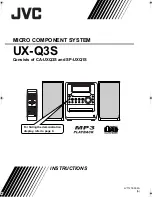
19
simultaneously add top-class echo to vocal channels, chorus to keyboard channels, short delay and gating to
drum channels, and master reverb to the overall mix� Internal signal routing eliminates the need for complex
external patching as well as the associated noise and interference problems� You can select, edit, and blend
effects until the desired mood and texture are achieved without sacrificing performance or flexibility. The fact
that the equivalent of four high-performance digital effect processors are built right into the console actually
delivers performance and versatility that exceed what you’d have with external effects�
●
Virtual Rack
Yamaha’s Virtual Rack concept lets you approach and manage the console’s internal effects and EQ in the same way you
would with an external rack system, for intuitive, efficient operation� You can stack effect and EQ units in the rack and patch
them into the system via a comprehensive interface that effectively simulates a hardware rack environment� For example,
you could mount a graphic equalizer for the main outputs in the topmost rack space, and another for monitor output in
the second rack space, and so on� And since input and output patching is handled using easy-to-understand bus names,
there’s less chance of making connection errors than when using unmarked or numbered cables�
●
Selected Channel
The Selected Channel section is a common feature on Yamaha digital consoles, and it includes all the controls and
functions you’d normally find in each channels module of a conventional analog mixer, and plenty more� You select the
channel you want to work on by pressing it’s [SEL] key, then use the Select Channel encoders and keys to directly edit the
channel parameters: input gain, EQ, dynamics, panning, MIX/MATRIX bus send level, and more� And with this interface
you can control the entire console without having to move from the optimum listening position� In addition to hands-on
operation via the Selected Channel controls, parameter values and graphs displayed on the console’s LCD panel provide
precise visual feedback and confirmation� This type of centralized operation and display allows the engineer to concentrate
more fully on the job at hand while providing operating ease that allows extra leeway for creativity�
●
Sends On Fader
The Sends On Fader mode allows the mix bus send levels to be directly controlled via the channel faders� Since the send
levels to the mix buses appear on the physical faders in this mode, you can visualize the relative levels of the entire send
mix at a glance, which can be a great advantage for monitor mixing applications, for example� In actually operation you
select a mix bus and the send levels to that mix bus appear on the faders, so if a player asks for “a little more kick and
snare,” or wants you to “boost the vocals and bass a bit,” you can simply reach for the appropriate faders and make the
required adjustments immediately�
●
User Defined Keys
As their name implies, these keys can be user-defined to perform a range of functions� You could, for example, assign mute
group [1] ~ [8] to USER DEFINED KEYS [1] ~ [8], allowing you to instantly mute or un-mute any group by simply pressing
the assigned key� The USER DEFINED KEYS are also a great way to control the LS9’s new USB Memory recorder
function� Instead of having to call up the recorder’s transport controls on the display, you could assign USER DEFINED
KEY [11] to start recording, and key [12] to stop recording, for example� That way you can quick start and stop recording
whenever necessary� Other functions you might want to assign to the USER DEFINED KEYS include scene recall, tap
tempo entry, and oscillator on/off, and you can bookmark display pages you use frequently for instant recall� In a compact
digital mixer with this many features and functions it is simply not possible to make all of them directly accessible via the
panel at all times� But with the USER DEFINED KEYS you can make the functions you need to access most often easily
available at all times�
The Selected Channel interface allows
complete control from the display position.
Press one of the 16 MIX/MATRIX keys twice and
all other MIX/MATRIX keys will light while the
pressed button flashes. At the same time “SENDS
ON FADER” will flash on the display to indicate
that the Sends On fader mode is active.
SPX000
Summary of Contents for LS9 Editor
Page 22: ...Block Diagram 22...
Page 23: ...23...





































